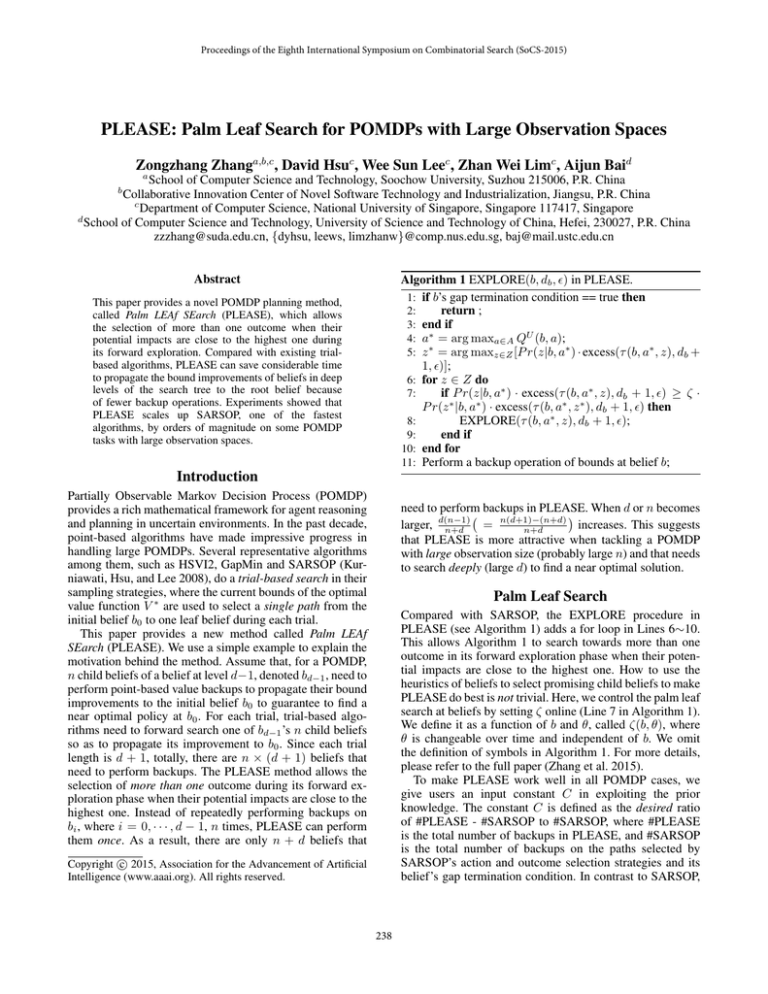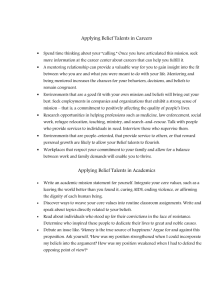
Proceedings of the Eighth International Symposium on Combinatorial Search (SoCS-2015)
PLEASE: Palm Leaf Search for POMDPs with Large Observation Spaces
Zongzhang Zhanga,b,c , David Hsuc , Wee Sun Leec , Zhan Wei Limc , Aijun Baid
a
School of Computer Science and Technology, Soochow University, Suzhou 215006, P.R. China
Collaborative Innovation Center of Novel Software Technology and Industrialization, Jiangsu, P.R. China
c
Department of Computer Science, National University of Singapore, Singapore 117417, Singapore
d
School of Computer Science and Technology, University of Science and Technology of China, Hefei, 230027, P.R. China
zzzhang@suda.edu.cn, {dyhsu, leews, limzhanw}@comp.nus.edu.sg, baj@mail.ustc.edu.cn
b
Abstract
Algorithm 1 EXPLORE(b, db , ) in PLEASE.
1: if b’s gap termination condition == true then
2:
return ;
3: end if
4: a∗ = arg maxa∈A QU (b, a);
5: z ∗ = arg maxz∈Z [P r(z|b, a∗ ) · excess(τ (b, a∗ , z), db +
1, )];
6: for z ∈ Z do
7:
if P r(z|b, a∗ ) · excess(τ (b, a∗ , z), db + 1, ) ≥ ζ ·
P r(z ∗ |b, a∗ ) · excess(τ (b, a∗ , z ∗ ), db + 1, ) then
8:
EXPLORE(τ (b, a∗ , z), db + 1, );
9:
end if
10: end for
11: Perform a backup operation of bounds at belief b;
This paper provides a novel POMDP planning method,
called Palm LEAf SEarch (PLEASE), which allows
the selection of more than one outcome when their
potential impacts are close to the highest one during
its forward exploration. Compared with existing trialbased algorithms, PLEASE can save considerable time
to propagate the bound improvements of beliefs in deep
levels of the search tree to the root belief because
of fewer backup operations. Experiments showed that
PLEASE scales up SARSOP, one of the fastest
algorithms, by orders of magnitude on some POMDP
tasks with large observation spaces.
Introduction
Partially Observable Markov Decision Process (POMDP)
provides a rich mathematical framework for agent reasoning
and planning in uncertain environments. In the past decade,
point-based algorithms have made impressive progress in
handling large POMDPs. Several representative algorithms
among them, such as HSVI2, GapMin and SARSOP (Kurniawati, Hsu, and Lee 2008), do a trial-based search in their
sampling strategies, where the current bounds of the optimal
value function V ∗ are used to select a single path from the
initial belief b0 to one leaf belief during each trial.
This paper provides a new method called Palm LEAf
SEarch (PLEASE). We use a simple example to explain the
motivation behind the method. Assume that, for a POMDP,
n child beliefs of a belief at level d−1, denoted bd−1 , need to
perform point-based value backups to propagate their bound
improvements to the initial belief b0 to guarantee to find a
near optimal policy at b0 . For each trial, trial-based algorithms need to forward search one of bd−1 ’s n child beliefs
so as to propagate its improvement to b0 . Since each trial
length is d + 1, totally, there are n × (d + 1) beliefs that
need to perform backups. The PLEASE method allows the
selection of more than one outcome during its forward exploration phase when their potential impacts are close to the
highest one. Instead of repeatedly performing backups on
bi , where i = 0, · · · , d − 1, n times, PLEASE can perform
them once. As a result, there are only n + d beliefs that
need to perform backups in PLEASE. When d or n becomes
larger, d(n−1)
= n(d+1)−(n+d)
increases. This suggests
n+d
n+d
that PLEASE is more attractive when tackling a POMDP
with large observation size (probably large n) and that needs
to search deeply (large d) to find a near optimal solution.
Palm Leaf Search
Compared with SARSOP, the EXPLORE procedure in
PLEASE (see Algorithm 1) adds a for loop in Lines 6∼10.
This allows Algorithm 1 to search towards more than one
outcome in its forward exploration phase when their potential impacts are close to the highest one. How to use the
heuristics of beliefs to select promising child beliefs to make
PLEASE do best is not trivial. Here, we control the palm leaf
search at beliefs by setting ζ online (Line 7 in Algorithm 1).
We define it as a function of b and θ, called ζ(b, θ), where
θ is changeable over time and independent of b. We omit
the definition of symbols in Algorithm 1. For more details,
please refer to the full paper (Zhang et al. 2015).
To make PLEASE work well in all POMDP cases, we
give users an input constant C in exploiting the prior
knowledge. The constant C is defined as the desired ratio
of #PLEASE - #SARSOP to #SARSOP, where #PLEASE
is the total number of backups in PLEASE, and #SARSOP
is the total number of backups on the paths selected by
SARSOP’s action and outcome selection strategies and its
belief’s gap termination condition. In contrast to SARSOP,
c 2015, Association for the Advancement of Artificial
Copyright Intelligence (www.aaai.org). All rights reserved.
238
C > 0 reduces the number of backups to propagate the
bound improvements of selected leaf nodes to the root node.
Please see (Zhang et al. 2015) for a variant of PLEASE
(called PLEASE-Z) with a different definition of C.
We let PLEASE control θ online so that it obtains an ideal
value of θ over time to make the actual ratio of #PLEASE to
#SARSOP close to C + 1. Specifically, we define θ by using
the following rule:
(
θ=
min{θ + ∆, 1}
max{θ − ∆, θl }
Table 1: Comparison of SARSOP and PLEASE.
Algorithm
Gap V L (b0 ) V U (b0 )
Time
Tag(55) (|S| = 3, 080, |A| = 5, |Z| = 56)
SARSOP
5.21
-9.89
-4.68
9,836
PLEASE(C=4)
5.21
-9.88
-4.67
1,527
Two-Robot Tag (|S| = 14, 400, |A| = 25, |Z| = 625)
SARSOP
6.56
-12.28
-5.72
99,972
PLEASE(C=10)
6.53
-11.88
-5.35
4,174
Tag(85) (|S| = 7, 310, |A| = 5, |Z| = 86)
SARSOP
7.02
-12.45
-5.43
9,995
PLEASE(C=6.23) 7.02
-12.18
-5.16
583
Tag(102) (|S| = 10, 506, |A| = 5, |Z| = 103)
SARSOP
7.68
-13.56
-5.88
9,993
PLEASE(C=6.48) 7.66
-13.15
-5.49
365
Hallway (|S| = 60, |A| = 5, |Z| = 21)
SARSOP
0.18
1.01
1.19
9,995
PLEASE(C=4.26) 0.18
1.00
1.18
115
Hallway2 (|S| = 92, |A| = 5, |Z| = 17)
SARSOP
0.46
0.42
0.88
9,990
PLEASE(C=3.96) 0.46
0.40
0.86
426
FieldVisionRockSample 5 5 (|S| = 801, |A| = 5, |Z| = 32)
SARSOP
0.47
23.27
23.74
9,764
PLEASE(C=4.85) 0.47
23.28
23.75
3,585
HomeCare (|S| = 5, 408, |A| = 9, |Z| = 928)
SARSOP
2.98
16.77
19.75
99,686
PLEASE(C=9.56) 2.96
16.77
19.73
3,706
#PLEASE
if #
SARSOP ≥ C + 1,
otherwise.
Here, θ is set to θ0 = 1 in the beginning of PLEASE, θl =
0.8, and ∆ = 0.01 in this paper. PLEASE adjusts the value
of θ in the beginning of each forward exploration phase from
the initial belief b0 in the PLEASE method.
∗ √
PLEASE defines ζ(b, θ) = dis(b,p )+1 θ by using θ and
b’s heuristic information to achieve the goal of giving more
time to do palm leaf search in promising beliefs with deep
levels. Here, p∗ represents the path generated by SARSOP’s
action and outcome selection strategies and its belief’s gap
termination condition, and the distance from b to p∗ , denoted
dis(b, p∗ ), as the number of beliefs that b needs to go through
to arrive in p∗ . Such a formula guarantees that PLEASE does
more aggressive palm leaf search around the current best
path p∗ in each forward exploration phase starting at b0 .
Essentially, palm leaf search can be viewed as a kind of
complete anytime best-first beam search in POMDPs. Similar techniques of tree-trials have been used in Monte-Carlo
tree search, such as df-UCT by Yoshizoe et al. (2011). At
each step, the complexity of each PLEASE exploration step
is at least the time and space complexity of each SARSOP
step. However, its conservative theoretical time bound of
finding an -optimal policy is verifiable to be not worse than
the original trial-based algorithm.
problems. For example, when the gap is 3.43 on HomeCare,
the number of α-vectors in PLEASE is 7,947, while 30,633
in SARSOP. Third, when the gaps were the same, SARSOP
and PLEASE’s expected total rewards appeared to be similar with each other. Specifically, expected total reward was
−9.73 ± 0.12 on Tag(55) when the gap was 5.21; the reward was −11.58 ± 0.12 on Two-Robot Tag(24) when the
gap was 7.43; and the expected reward was 17.03 ± 0.14 on
HomeCare when the gap was 3.43.
Experiments
Future Topics One topic is to enrich the theoretical analysis of the heuristic for observation selection in the current
PLEASE method. Another interesting topic is how to use
more heuristic information of beliefs (e.g., the depth information of beliefs) in defining the threshold function ζ(b, θ).
We use Tag(55) and Two-Robot Tag, the two POMDP problems with large observation spaces, to study the effects of
varying the tuning parameter C. Empirical results show that
C = 4 and 10 are good candidates for the two problems, respectively. We use C = m log10 |Z|, inspired by the fact that
C should be larger when |Z| increases, as a simple formula
to set the input constant automatically. Here, m = 3.22 is
fitted by using the least squares method, which uses C = 4,
|Z| = 56 from the Tag(55) problem and C = 10, |Z| = 625
from the Two-Robot Tag problem as the training set.
Table 1 compares PLEASE with SARSOP on 8 benchmark problems in terms of the gap between bounds at b0
(V U (b0 ) − V L (b0 )), the lower bound V L (b0 ), the upper
bound V U (b0 ) and the total running time (in seconds). On
most of these problems this table shows that PLEASE is substantially faster than SARSOP by orders of magnitude.
There are three other observations obtained from more
detailed data in our experiments. First, the performance of
HSVI2 on our test problems is worse than SARSOP in
most cases, and GapMin variants are not efficient in tackling
large problems. Second, compared with SARSOP, PLEASE
needed much fewer α-vectors to get the same gaps on test
Acknowledgements
This work was supported in part by MoE AcRF grant 2010T2-2-071 and Collaborative Innovation Center of Novel
Software Technology and Industrialization.
References
Kurniawati, H.; Hsu, D.; and Lee, W. 2008. SARSOP: Efficient point-based POMDP planning by approximating optimally reachable belief spaces. In RSS.
Yoshizoe, K.; Kishimoto, A.; Kaneko, T.; Yoshimoto, H.;
and Ishikawa, Y. 2011. Scalable distributed Monte-Carlo
tree search. In SoCS, 180–187.
Zhang, Z.; Hsu, D.; Lee, W.; Lim, Z.; and Bai, A. 2015.
PLEASE: Palm leaf search for POMDPs with large observation spaces. In ICAPS, 249–257.
239








